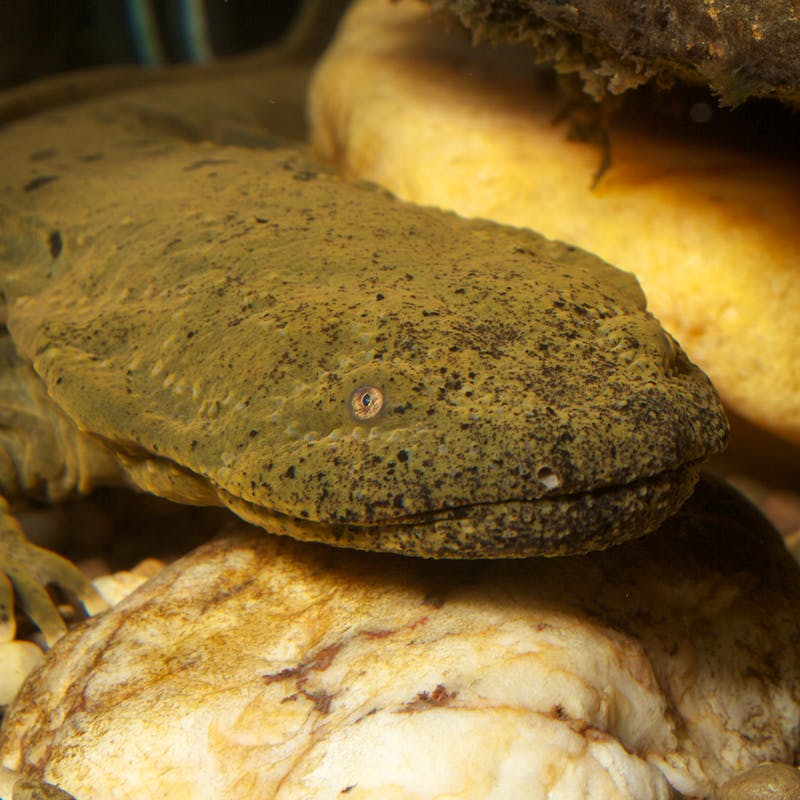There was an old bridge stretching across hellbender habitat in Madison County, North Carolina. Lori Williams, a wildlife diversity biologist with the North Carolina Wildlife Resources Commission (NCWRC), got word from a colleague at North Carolina’s Department of Transportation (NCDOT) that it was being demolished. NCDOT offered Lori the opportunity to quickly organize a team to search for and move any hellbenders to safety. Lori invited Defenders to join her crew of biologists and Laurel Community Center Organization volunteer, Mary Kelly. With some quick collaboration and expertise, these hellbenders had a chance at rescue.
A few hurried conversations, fast action from volunteers, and Lori’s perseverance made all the difference. Two adult hellbenders were spotted and carefully removed and relocated downstream to more suitable habitat.
Hellbenders are an imperiled species throughout their range and a “Species of Greatest Conservation Need” in North Carolina. These large salamanders – up to two feet long – are struggling for survival due to land development and human encroachment. Without our help, they could have easily been crushed under falling debris from the demolished bridge. The loss of breeding-age adults means the loss of future generations.
Ben Dalton, a wildlife diversity technician from North Carolina Wildlife Resources Commission, Mary Kelly, a volunteer from the Laurel Community Center and Michael Hampton, a Southeast Defenders of Wildlife intern are featured in the search and rescue video.
Here’s How We Did It
Our crew of five biologists and volunteers snorkeled shoulder-to-shoulder the width of the creek, starting about 40 meters downstream from the newly constructed bridge. We used flashlights to look under every large flat rock, submerged log and crevice for hellbenders until we passed the old bridge slated for demolition. If the rock was too large to lift, we called on the ground crew for tools and support. The two adult male hellbenders we found were under large flat rocks near the old bridge. Our intern, Tory Ash, was the first to spot one of the hellbenders. Tory got a lot of hellbender survey experience with us and Lori’s NCWCR team this summer.
After capturing the hellbenders with a net, we took them about a mile downstream where hellbenders had been found in the past. Hellbenders live in rivers and large streams with shallow, cold, clean, silt-free, shaded and fast-moving water with high oxygen levels. Their habitats should also contain large, flat rocks or submerged trees for nesting and protection, as well as prey like crayfish – their favorite food.
Making a Difference
In the decades I’ve been doing this work, I am most frequently asked two questions: “Do you think what you’re doing helps imperiled species, given the many threats facing our planet?” And “Do you ever collaborate with other groups and agencies?” This hellbender search-and-rescue effort is just one example demonstrating my answers: “Yes!” and “Yes!”
Every action we take offers a chance at protecting biodiversity, and many of those actions require communication and collaboration from different people, agencies and groups who are willing to help. In this case, the NCDOT and Lori’s network of biologists and volunteers were instrumental in our collective success. Furthermore, this rescue reconnected me to Mary and we established a partnership between our organizations. I am looking forward to giving a hellbender presentation for Laurel Community Center and collaborating with them more soon! The old saying “it takes a village” is certainly true when it comes to saving these special salamanders. With more efforts like these – spanning across multiple state agencies, local community members and Defenders of Wildlife – we can increase the opportunity for future generations to thrive.






